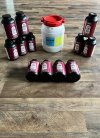dolomite_supafly
Well-Known Member
I used to but I don't anymore.
The reason why is even though the powders are the same the individual grains can vary greatly. And lots with bigger grains will float to the top and smaller grains work their way down.
Here is a powder reference with microscopic pictures. You can see different lots are different sizes and often use different ingredients. The different ingredients are probably used to standardize the burn rate.
http://www.ilrc.ucf.edu/powders/search.php
The reason why is even though the powders are the same the individual grains can vary greatly. And lots with bigger grains will float to the top and smaller grains work their way down.
Here is a powder reference with microscopic pictures. You can see different lots are different sizes and often use different ingredients. The different ingredients are probably used to standardize the burn rate.
http://www.ilrc.ucf.edu/powders/search.php


